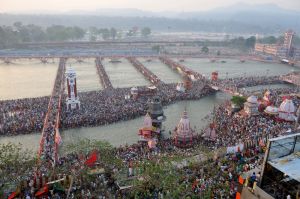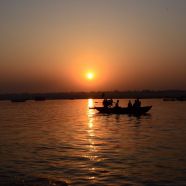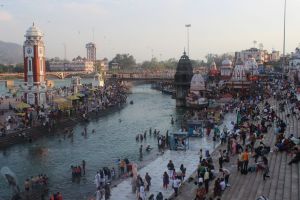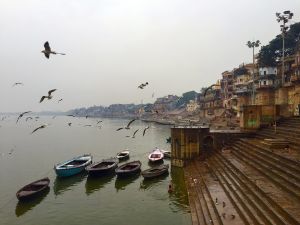The Ganga and the Indian Culture
The Ganga, rising in the Himalayas and emptying into the Bay of Bengal, flows through one of the most densely populated regions in the world. Draining nearly one-fourth of the Indian subcontinent, it cuts through the heartland of India where its earliest kingdoms were situated. On its banks, thousands of years ago, sages established ashrams and composed hymns and texts that form the core of the Vedic tradition. The wisdom of the Vedic rishis, in its various forms such as Yoga and Vedanta, continues to inspire people in India and the rest of the world, and Vedic hymns are chanted today as they were millennia ago.
The river begins as the Bhagirathi at the edge of the Gangotri Glacier at the height of 13,200 feet. It becomes the Ganga after joining up with the Alakananda at Devaprayag. Other tributaries merge into it before it flows from the mountains at the ashram town of Rishikesh and then moves into the plains just a few miles south at the pilgrimage city of Haridwar.
In its course of 1,500 miles, the Ganga passes through ancient cities such as Kannauj, Prayag, Varanasi, and Patna and via its distributaries in the modern cities of Kolkata and Dhaka; the modern capital of Delhi and the Mughal capital of Agra are on its tributary, the Yamuna. Its first major distributary is the Bhagirathi-Hooghly, which travels through West Bengal. Upon entering Bangladesh, it is known as the Padma and joins the Jamuna River, the name by which the Brahmaputra is known here. Farther downstream, the Padma joins the Meghna River and takes on that name as it enters the Meghna Estuary, which empties into the Bay of Bengal. The Ganga delta is the world’s largest by breadth, which extends to 220 miles, and third largest by volume.
The famous River Hymn of the Ṛgveda lists ten rivers of which the Ganga appears to be the easternmost with Sarasvati to its west. Archaeological remains of the Sindhu-Sarasvati tradition (also called Indus civilization) that go back to about 8000 bce have the Sarasvati River as the main focus with most sites scattered in its valleys. The Sarasvati arose in the Himalayas just to the west of the Ganga and it is lauded in another Vedic hymn as the greatest river of its time, going from the mountains to the sea.
Scholars believe that changes in climate and earthquakes caused the Sarasvati to dry up in the Western Desert about 2000 bce. Some have speculated that the main cause of the diminution of the Sarasvati was that the course of its tributary, Yamuna, changed toward the Ganga after a major earthquake. By the time of the Ramayana, the Mahabharata, and the encyclopedic Puranas, the Ganga was the preeminent river of Indian culture. But, Sarasvati was not forgotten. Since it didn’t reach all the way down to the sea, it was imagined to join up with the Ganga—and the tributary Yamuna—through a subterranean passage at Prayag (Allahabad). If the Ganga was the river carrying Indian culture in its broadest sense, Sarasvati remained the goddess of wisdom and learning.
The Descent of the Ganga
The Ganga embodies all sacred waters in Hindu mythos and it is invoked in ritual just as Sarasvati was in an earlier age. There are three Gangas: in the heavens as the Milky Way; the familiar terrestrial river of north India; and a subterranean river. The mythology of the river can be understood within the context of Vedic cosmology according to which reality is recursive and the skies are mirrored on the earth and within one’s being and everything is interconnected.
The samudra manthana (churning of the ocean) is one of the central themes of the Vedas, and it not only takes place at the cosmic level but also in the heart of each individual by the dictum yat brahmāṇḍe tad piṇḍe (as in the cosmos, so in the body). The recursion carries into the very neural pathways of the body and I have seen an Ayurveda text showing channels in the brain that mirror the Sarasvati and the Ganga.
The Vedic sages, meditating on the banks of the Ganga and the Sarasvati, arrived at a subtle understanding of reality. They claimed that although consciousness is the one single basis of reality, limitations of the mind and of form engender duality of experience that becomes the source of ignorance and suffering. They came up with many means to overcome bondage and to find divinity within. These means can be viewed as the joining of the celestial and material currents in mind and body.
Ritual is one way to liberation. It is sacred theater that helps one dissociate from reflexive behavior to find the center of one’s being. But it can also become reflexive, the sages warn, and, therefore, creativity is essential even in ritual. Other methods to salvation include direct pursuit of knowledge, devotion, service, and even a life of action that includes contemplation.
The variety of prescriptions may appear to be an excessively eclectic approach to living life. But it makes perfect sense and as the art historian Heinrich Zimmer stated in his book, Philosophies of India: “The whole edifice of Indian civilization is imbued with spiritual meaning. The close interdependence and perfect harmonization of the two serve to counteract the natural tendency of Indian philosophy to become recondite and esoteric, removed from life and the task of the education of society. In the Hindu world, the folklore and popular mythology carry the truths and teachings of the philosophers to the masses.”
The point of the story of the descent (avatarana in Sanskrit) of the heavenly Ganga to Earth is to stress the connections between the spiritual and the material. The descent was a boon to King Bhagīratha who undertook austerities to restore ancestors who had met untimely deaths, and the river is, therefore, also called Bhagirathi. However, since her turbulent force would shatter the earth, Bhagīratha entreats the Great God Śiva to receive Ganga in the coils of his hair to break her fall. From Śiva’s dreadlocks the waters are released to many waterways in the Himalayas and to a subterranean channel. For this act, Śiva is depicted in Hindu iconography as Gangādhara (Bearer of the Ganga), with the river shown as a spout of water rising from his hair.
The Ganga is seen replicated beyond the plains of north India. The Godavari in Central India and the Kaveri in South India are each the Ganga of its region. Hindus in far lands choose a local river for the purificatory ritual.
Because Ganga descended to Earth, she is also the vehicle of ascent to the heavens. This ascent is accomplished by an actual or symbolic crossing of the river. For laypersons, the crossing is done at the fords (tīrtha in Sanskrit) but for the learned it is through a training of the mind by one of the many forms of yoga. A person is deemed blessed if given a sip of Ganga-water on their deathbed.
The waters of the Ganga are considered purifying. People are aware that large portions of the river are now badly polluted but its effects are ultimately spiritual. The Ganga is all accepting and forgiving and it connects the worshiper to the larger currents of life.
Hindu temples all over India had statues and reliefs of the goddess carved at their entrances. The Ganga’s mount is the makara, which has the lower jaw of a crocodile, the snout or trunk of an elephant, the tusks and ears of a wild boar, the darting eyes of a monkey, the scales and the flexible body of a fish, and the hind feathers of a peacock. She is shown carrying a full vase (kumbha or kalasha), which represents auspiciousness, fertility, and generative power. She is also shown with a parasol.
Varanasi, the City of Light
Varanasi, known for its fine silk and cotton fabrics, perfumes, ivory works, and sculpture, is one of the most famous pilgrimage centers on the Ganga and also one of the oldest continuously inhabited cities anywhere. Known also as Banaras, it is situated on the western bank at a place where it takes a broad crescent sweep toward the north. Seen from the river at dawn, the high-banked face of the city looks luminous, explaining its old name, Kashi (Kāśī, City of Light).
Most of all, Varanasi is the city of Śiva and the home of the great Kashi Vishvanath temple. This temple, which is called the Vishveshvara, has Śiva’s jyotirlinga, the icon of sheer light, from which Kashi gets its name. The three hills in the city are seen as the tips of Śiva’s trident. During the eleventh to the seventeenth centuries, Muslim invaders destroyed the Kashi Vishvanath at least four times and it was last rebuilt by the Maratha queen Ahilyabai Holkar in 1780.
In the sixth century bce, the Buddha visited Varanasi and in nearby Sarnath he delivered his first sermon. Varanasi is also home to two of India’s great devotional poets, Kabir and Tulsidas. The Chinese traveler Xuanzang (earlier spelling Hiuen Tsang), who visited Varanasi in the seventh century, attested that the city was a center of religious and artistic activities, and that it extended for over three miles. He further described a mass bathing ritual held during the reign of Emperor Harsha at the confluence of Ganga and Yamuna in Prayag.
The eighty-four ghats—a series of steps leading to the river—along the arc-shaped Ganga symbolize the integration of the twelve signs of the zodiac with the seven divisions of space and time. Every morning approximately twenty thousand people arrive at the ghats for puja, the ritual bath, or just to gather. The number of bathers approaches a million on special occasions such as the full moon in October–November (Karttika Purnima) and on solar and lunar eclipses.
One of most important pilgrimages in the approximately fifty-mile Panchakroshi circuit around Varanasi includes visits to many temples, and pedestrians take a few days to complete it. For the faithful, Varanasi is the holiest of places, as celebrated below in a poem found in the Kashi section of the ancient Skanda Purana.
Are there not many holy places on this earth?
Yet which of them would equal in the balance one speck of Kāshī’s dust?
Are there not many rivers running to the sea?
Yet which of them is like the River of Heaven in Kāshī?
Are there not many fields of liberation on earth?
Yet not one equals the smallest part of the city never forsaken by Shiva.
The Ganga, Shiva, and Kāshī: where this Trinity is watchful, no wonder
here is found the grace that leads one on to perfect bliss.(Kāshī Khanda 35.7–10, from Banaras: City of Light by Diana L. Eck)
Count Herman Keyserling, in his highly regarded Indian Travel Diary (1914), wrote thus of Varanasi: “Benares is holy. Europe, grown superficial, hardly understands such truths anymore. . . . I feel nearer here than I have ever done to the heart of the world; here I feel every day as if soon, perhaps even to-day, I would receive the grace of supreme revelation. . . . The atmosphere of devotion which hangs above the river is improbable in its strength: stronger than in any church that I have ever visited. Every would-be Christian priest would do well to sacrifice a year of his theological studies in order to spend this time on the Ganga: here he would discover what piety means. For in Europe all that exists is its remote reflection.”
The Kumbha Mela
The origin of the Kumbha as a congregational ritual is in the churning of the ocean by the devas (gods) and the asuras (demons). The purpose of this churning is the amrita (nectar of immortality) that both the devas and the asuras covet. At last, as the churning proceeds, a kumbha appears and in the struggle between the two parties to get hold of it, amrita spills at four places: Haridwar, Prayag, Nashik, and Ujjain on the banks of Ganga, the confluence of Ganga and Yamuna, Godavari, and Kshipra, respectively.

Haridwar, April 14, 2010: Pilgrims gather at the third Shahi Snan in Har ki Pauri to take the Royal Bath in the Ganges. Video still from the documentary “Amrit Nectar of Immortality”. Photograph attributed to Coupdoeil.
The seeker wishes to connect to the cosmic by journeying to the Mela at the four places where the amrita fell. In this he is guided by Brihaspati (Jupiter), the teacher of the devas, and the pilgrimage is completed with a bath in the river. Since the orbit of Jupiter is twelve years, the Kumbha comes around at this frequency. The specific month is determined by the conjunction of Jupiter with a different nakṣatra associated with the place. Every 144 years, the Mela is called a Mahakumbha.
Mark Twain visited the Kumbha Mela of Prayag in 1895. Told that two million pilgrims come to the Mela, he spoke of his experience thus: “It is wonderful, the power of a faith like that, that can make multitudes upon multitudes of the old and weak and the young and frail enter without hesitation or complaint upon such incredible journeys and endure the resultant miseries without repining.”
The Kumbha Melas were traditionally managed by the akharas (organizations of sadhus), but now the government makes the general arrangements. The Melas are the greatest peaceful congregations of people and there are reports that the Prayag Kumbha of 2013 attracted nearly 120 million people.
Pushkaram (or just Pushkar) is another festival dedicated to the worshiping of twelve sacred rivers that range from the Ganga to the Kaveri. This celebration takes place at specific temples along the banks in a manner quite like the Kumbha. Each river is associated with a zodiac sign, and the river for each year’s festival is based on the conjunction of the river sign with Jupiter.
The sequence of great ritual associated with the Ganga and other rivers in India is to help the seeker find connection with the cosmos. Indian social theorists, in the dharmaśāstras, foresaw the problem of emptiness arising from materialism, and to counter this resulting emptiness, they exalted the idea of renunciation and self-denial. To them the pursuit of happiness was a subtle dance between enjoyment and sacrifice.
To find the balance in one’s own life there is nothing as instructive as getting lost and rendered anonymous in the vast multitudes of the Kumbha. This is one of the reasons the Westerner is so fascinated by the congregations. These Melas, the Pushkarams, and other pilgrimages are a wonderful system of spiritual journeying that is distributed across the entire land of India. They offer participation in a deeply personal yet universal act that has the potential to heal and let each person connect with the larger current of humanity.











Enriching article
Thank you for this inspiring article. It seems to me as if in India there is just a curtain between this material reality and the more subtle realities, whereas in the west, a brick wall seems to separate them. In this context, it may surprise most westerners but not most Indians that the Uttarakhand High Court has recently declared Ganga as a living legal entity.
We visited the maha kumbhmela of 2013 in Prayag and that visit is imprinted in my psyche for ever! Your article just like every other is very enlightening..
I am stunned and speechless. You have taken us to a different world
I firmly believe that God exists for me ONLY when whole world follow the path of Advaita Vedanta. Not driven by any external tyrant force but by self-convinced internal love for Humanity.
Only ancient Indian that is Hindu philosophy can counter the forces of conversion and killing by it’s inherent loving force for sustaining Humanity for centuries to come